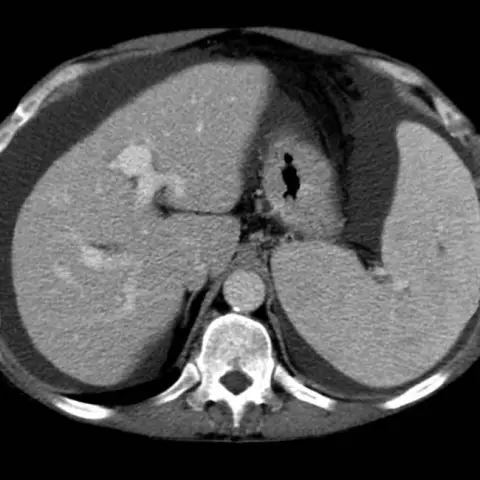- Author Rachel Wainwright [email protected].
- Public 2023-12-15 07:39.
- Last modified 2025-11-02 20:14.
Benign prostatic hyperplasia

Benign prostatic hyperplasia (adenoma) is a disease in which a small knot (or knots) forms in the prostate that grow and gradually compress the urethra. In this case, the disease is accompanied by a violation of urination. Adenoma of the prostate does not metastasize, therefore it is called benign, which, in fact, is its difference from prostate cancer.
According to statistics, every second man falls ill with prostate adenoma after 50 years. Therefore, prostate adenoma is one of the most common urological diseases.
Causes of prostate adenoma
The reliable causes of benign hyperplasia are unknown. Since the disease occurs more often in old age, it is believed that adenoma is one of the symptoms of male menopause.
No connection was found between benign hyperplasia and sexual preferences, sexual activity, alcohol consumption, smoking and previous venereal and inflammatory diseases.
Symptoms of benign prostatic hyperplasia
The main symptom of the disease is urination disorder. It is believed that hyperplasia begins when urination is no longer a pleasure. This is a signal that it is time for a man to see a urologist.
Hyperplasia makes urination less intense and more frequent over time. The stream of urine becomes weak, and the amount of urine excreted at one time decreases. The patient gets up several times at night to go to the toilet.
Also, the symptoms of prostatic hyperplasia are such a strong urge to urinate that the patient cannot delay them for a minute. Unfortunately, most men tend to attribute this symptom to aging, and rarely see a doctor.
As the adenoma grows, it becomes more difficult to urinate. The stream of urine falls almost vertically, and not along a curve. To carry out full-fledged urination, a man begins to strongly strain his abdominal muscles. Sometimes this leads to severe fatigue and the man has to interrupt during urination to rest.
In the absence of timely treatment of benign prostatic hyperplasia, complications occur in patients. So, in the first place, the kidneys are affected. Patients develop kidney failure, which is manifested by dry mouth, thirst, headache, irritability, and weakness. The bladder is always full of urine, but urination is very scanty. At the same time, the phenomena of urinary incontinence are observed, which at first occur only at night, but then during the day.
Complications of prostate adenoma
In the absence of treatment for benign prostatic hyperplasia, the process ends with a complete squeezing of the urethra, which leads to acute urinary retention. This is accompanied by strong and sharp painful sensations in the lower abdomen.
It should be noted that urinary retention can occur at the very beginning of the disease due to hypothermia, prolonged non-emptying of the bladder, excessive alcohol intake, malnutrition, etc.
Often with prostate adenoma, hematuria can be observed - blood in the urine. The increased pressure of urine in the bladder damages the veins, which causes bleeding. Bladder stones can also be a consequence of prostate adenoma, as they are formed as a result of stagnant urine.
Methods for the diagnosis of benign prostatic hyperplasia
The urologist first of all interviews the patient, after which he probes his prostate gland through the rectum.
To clarify the diagnosis, the patient must be sent to the following studies:
- general blood and urine tests;
- ultrasound procedure;
- cystoscopy;
- x-ray of the pelvis;
- uroflowmetry (assessment of the flow rate of urine).
In case of acute urinary retention, the patient is immediately placed with a catheter to allow urine to flow out.
Treatment of benign prostatic hyperplasia

Depending on the stage and severity of the course of the disease, treatment can be medication, non-operative or operative.
Drug treatment can only help in the initial stages of the disease, when the patient's urethra is not yet completely compressed, and urine completely leaves the bladder. Today there are many drugs that not only significantly facilitate the course of the disease, but also help to reduce the volume of the prostate. However, these medications must be taken strictly as directed by the doctor and after undergoing a proper examination.
Non-operative treatments for benign prostatic hyperplasia include hyperthermia, bladder catheterization, balloon dilation, and thermal therapy. Catheterization is used in those patients who, due to various circumstances, cannot be operated on. Other non-operational methods in our countries have not yet been sufficiently studied, therefore they are not widely popular.
To date, the most successful and popular treatment for prostate adenoma is surgical. If the disease is not too advanced, the kidneys are not damaged, urine completely leaves the bladder, then it is preferable to perform a transurethral resection of the prostate. The operation consists in removing the prostate gland adenoma through the urethra. This surgical method is the least traumatic.
If the disease is in an advanced stage, there are signs of renal failure, the adenoma has reached a large size, and the bladder is constantly full, it would be more expedient to apply retropubic or transvesical adenomectomy. These two methods, despite the rather high trauma, guarantee a complete cure of the adenoma.
If a patient with prostate adenoma wishes to maintain sexual activity, then transurethral dissection of the prostate gland is preferred. This operation allows you to lead a healthy and fulfilling life for several years to come. However, in most cases a second operation will be required.
Prevention of prostate adenoma
Unfortunately, there are no effective methods of preventing prostate adenoma. It is believed that some herbal medicines reduce the risk of developing adenoma and increase potency. However, this information is not supported by any clinical trials.
In no case should you take the drugs that are used to treat it for the prevention of prostate adenoma.
As an alternative to prevention, it is possible to recommend all men over 50 years of age to undergo an annual examination by a urologist.
YouTube video related to the article:
The information is generalized and provided for informational purposes only. At the first sign of illness, see your doctor. Self-medication is hazardous to health!






